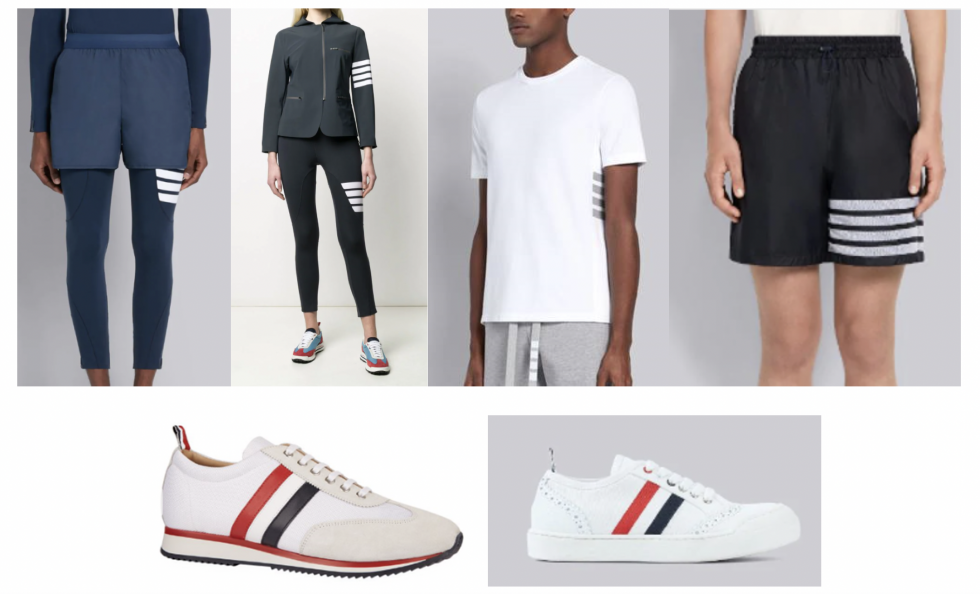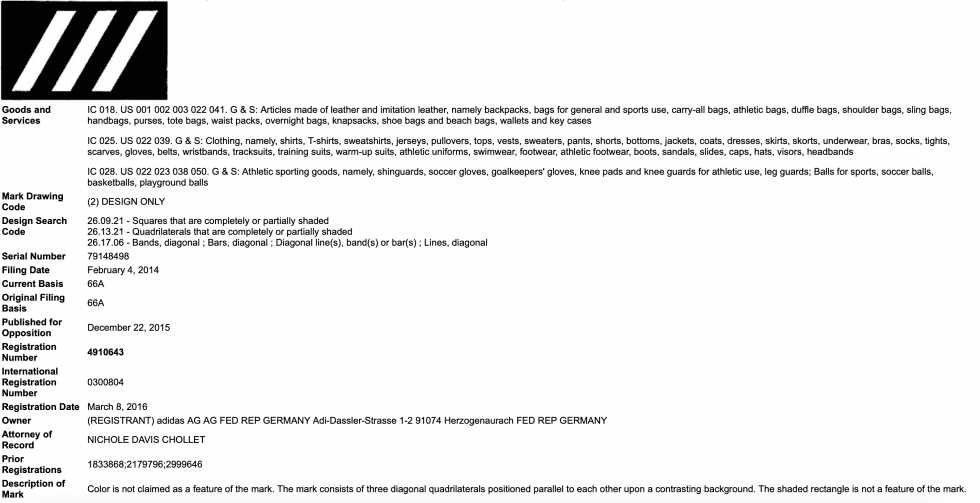Thom Browne and adidas are in court this week following the start of a jury trial that pits adidas’ mighty three-stripe trademark against a four-stripe logo that Thom Browne began using 15 years ago. Adidas is angling for a finding of trademark infringement – namely, that consumers are likely to be confused as to the nature/source of Thom Browne’s striped wares, and in particular, believe that they are affiliated with or otherwise authorized by adidas – and some $8 million in damages, while counsel for Thom Browne is leaning heavily into the argument that the two companies are situated differently in the market – adidas in sportswear and Thom Browne in the high fashion segment – and thus, are not competitors.
The trial in the U.S. District Court for the Southern District of New York follows from more than four years of back-and-forth between the parties since adidas initiated an opposition proceeding in 2018 in response to a trademark application that Thom Browne filed in the European Union for a striped mark. In December 2020, adidas filed a stateside opposition with the U.S. Patent and Trademark Office’s Trademark Trial and Appeal Board, urging the trademark body to put a stop to three pending trademark applications for red, white, and blue stripe trademarks for use on footwear that were filed by Thom Browne earlier that year. Adidas argued that Browne’s marks are confusingly similar to its own, pre-existing marks.

Setting the stage for the currently unfolding trademark trial (which is, of course, just as much about competition than it is about trademarks), adidas filed a trademark infringement and dilution suit against Thom Browne in June 2021. The German giant – which is notoriously litigious when it comes to its striped mark – alleged that Browne was engaging in “direct competition with [it] by offering sportswear and athletic-styled footwear that bear confusingly similar imitations” of its three-stripe mark. Aside from the obvious elements of competition at play, at the heart of adidas’ case is its claim that consumers “are likely to assume that [Thom Browne’s] goods originate from the same source, or that they are affiliated, connected, or associated with [adidas]” when no such affiliation exists. According to adidas, consumer confusion is particularly likely since Browne is using stripes in a manner that is “similar to [its own] three-stripe mark in appearance and overall commercial impression,” and Browne’s “goods are identical to the goods” that adidas has “long … offered in connection with the three-stripe mark.”
Thom Browne responded, in part, with an attempt to get one adidas’ three-stripe trademark registrations invalidated on the basis that the trademark registration for the mark – which consists of “three diagonal quadrilaterals positioned parallel to each other upon a contrasting background” – puts competitors at “a significant non-reputation-related disadvantage” since that it “is not limited to any specific number or orientation of stripes.” Counsel for Browne argued that in the case at hand, adidas is “asserting its registered trademark against Thom Browne over its use of four horizontal, parallel bands,” and thus, is “admit[ting] that its Three Quadrilaterals [mark] is not limited to a diagonal orientation or to three stripes.”
(Thom Browne, which was acquired by Zegna Group back in 2018, has also maintained from the outset despite adidas’ claims of confusion, there have not been any instances of actual confusion between its use of four horizontal parallel bands, and adidas’ use of three stripes.)

Unpersuaded by Browne’s claims, Magistrate Judge Lehrburger stated in his September 2022 recommendation and report that “aside from stating that ‘third party clothing designers use stripes’ in varying orientations and placements on apparel, Thom Browne has not alleged that the use of three parallel stripes – the subject of the challenged [adidas] registration – is ‘essential to effective competition in a particular market.’” As such, the Magistrate Judge stated determined that Thom Browne failed to “assert a plausible claim that the trademark protected by the challenged registration is aesthetically functional.” Judge Jed Rakoff, who is presiding over the trial, subsequently adopted this recommendation and sided with adidas in October.
Laches, Lack of Confusion
In opening statements this week, adidas’ lead counsel Kilpatrick Townsend’s Charles Henn asserted that adidas has maintained robust rights in the three-stripe mark since 1952, routinely spends roughly $300 million to advertise products bearing the mark each year, and generates revenues of upwards of $3 billion on apparel and footwear emblazoned with its three stripes. He also asserted that adidas first took issue with Browne’s use of the stripes back in 2007, when Thom Browne agreed to change a previously used three-stripe design to one with four stripes in 2007 after “adidas complained about Browne’s use of three horizontal parallel bands on its clothing.”
Counsel for adidas has doubled-down on its claims that Browne is not merely making high fashion items bearing the striped mark but aggressively – and increasingly – leaning into the sportswear market, including by way of an expanding collection of sports-related apparel and official deals with sports teams, such as European football club FC Barcelona, which is likely to confuse consumers. Not merely hypothetical, Henn pointed to survey evidence showing that nearly 30 percent of consumers associate striped Thom Browne wares with adidas.
In addition to highlighting differences in the two companies’ respective positions in the market (complete with different price points), counsel for Thom Browne, Robert Maldonado of Wolf, Greenfield & Sacks, has argued that adidas waited way too long to take action over its allegedly infringing use of stripes. Mirroring the laches, acquiescence, and estoppel arguments that it previously made in response to adidas’ complaint, counsel for Browne contends that while adidas complained about its use of three horizontal parallel bands on its clothing back in 2007, it did not complain about its use of four horizontal parallel bands on clothing until much more recently. And the “decade-long” delay between adidas knowing that Thom Browne was making use of a “four horizontal bar” design – which is different from three stripes, Maldonado argues – and taking action, is an “unreasonably” long time, per Browne.
Thom Browne’s counsel also set the stage for its plans to argue about the scope of adidas’ trademark rights, which it has asserted are far more limited than adidas has claimed, as well as others’ use of stripes as part of their own offerings (in an attempt to chip away at adidas’ claims), in the coming days.
The case is adidas America, Inc., et al., v. Thom Browne, Inc., 1:21-cv-05615 (SDNY).











